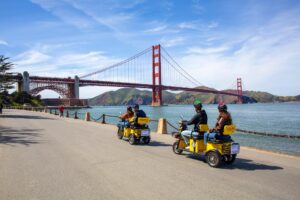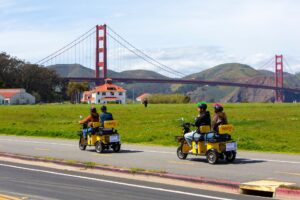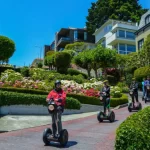Exploring the Historic Crab Stands at Fisherman’s Wharf
When you visit San Francisco’s iconic Fisherman’s Wharf, you’re in for a treat, especially if you’re a seafood lover. The historic seafood stands at Fisherman’s Wharf offer a mouthwatering variety of seafood delights, from fresh steamed crab to seafood cocktails, clam chowder, fried seafood, and shrimp salad sandwiches. In this article, we’ll dive into the history of this vibrant culinary scene, learn about the prized Dungeness crab, and discover how to make the most of your visit to this seafood paradise.
A Glimpse into History
Fisherman’s Wharf, nestled along the picturesque San Francisco Bay, has been the heart of the city’s colorful fishing fleet for over a century. Its fame, however, is largely attributed to the annual harvest of the delectable Dungeness crab. The opening of crab season in mid-November is a festive occasion, marked by the lighting of cauldrons along the wharf, ready to receive the first boxes filled to the brim with Dungeness crab.
Traditionally, the commencement of the crab season is preceded by a religious procession and a priestly blessing of the fishing fleet. The decks of fishing boats are piled high with crab traps, and the first day’s harvest is eagerly anticipated as a harbinger of what the season holds for the dedicated crabbers.
The Dungeness Crab: A Culinary Delight
The star of the show at Fisherman’s Wharf is undoubtedly the Dungeness crab. This crustacean is renowned for its succulent, sweet meat and is a cherished delicacy in San Francisco. It’s no wonder that the opening of crab season is a time for gourmet feasting that continues for months.
A century ago, Dungeness crabs were abundant in the waters stretching from the Straits of Carquinez to the sandy shores off Berkeley, Oakland, and Alameda. However, the disappearance of clams, the natural food of the crab, from the Bay led crabbers to venture just outside the Golden Gate to find the best catches. Today, they drop their crab pots in the depths of the ocean, near the Farallon Islands, in search of these prized crustaceans.
The Art of Crabbing
When crabbers reach their fishing grounds, their first task is to set crab traps, which resemble large wire tires. Each trap contains a bait jar, and once loaded, they are lowered into the ocean. Small marker buoys, painted with distinctive colors and tethered to the traps, float on the surface, marking the location. A single boat may deploy up to 200 pots. As night falls, the traps are set, and in the early dawn, it’s time to start hauling them in. Only the largest crabs are chosen, while the smaller ones are returned to the ocean to ensure a sustainable harvest.
Crab Stands and Seafood Delights
Before Fisherman’s Wharf had sidewalks or restaurants, some fishermen set up cauldrons of boiling water right on the waterfront. They cooked freshly caught crabs and served them in paper cups as a crab cocktail, a treat for early visitors. Over the years, many restaurants have emerged, each with a traditional steaming crab cauldron outside their premises. Attendants in smocks continue the tradition, offering visitors paper cups filled with fresh-cooked crab meat cocktails or whole cooked crabs to take home.
These establishments often feature dishes rooted in the culinary traditions of the fishermen’s ancestors, whether from Italy or San Francisco itself. It’s a dining experience like no other, steeped in history and culture, where you can savor the flavors of the sea.
How to Visit the Crab Stands at Fisherman’s Wharf
If you’re planning to experience the magic of Fisherman’s Wharf and savor the flavors of the Dungeness crab, here’s how to make the most of your visit:
- Plan Your Timing: Aim to visit during crab season, which typically starts in mid-November. This is when you’ll find the freshest Dungeness crab.
- Explore the Stands: Visit the historic crab stands at Fisherman’s Wharf, such as Crab Station, Guardino’s Crab Stand, Nick’s Lighthouse No. 5 Crab Stand, No. 9 Fishermen’s Grotto Crab Stand, and Sabella & La Torre’s Crab Stand. Each offers its unique twist on seafood delights.
- Try a Crab Cocktail: Don’t miss the opportunity to taste a crab cocktail – a classic treat with a rich history.
- Sample Local Dishes: Explore the diverse seafood dishes inspired by generations of fishermen’s families. It’s a culinary journey through time.
- Enjoy the Atmosphere: Take in the lively ambiance of Fisherman’s Wharf, with its breathtaking views of the bay and the bustling activity of the fishing fleet.
Visiting the historic crab stands at Fisherman’s Wharf is not just a gastronomic adventure; it’s a chance to immerse yourself in San Francisco’s maritime heritage. So, when you’re in the Bay Area, be sure to savor the flavors of the sea at this iconic destination.
Take time to Savor San Francisco’s Culinary Delights at Fisherman’s Wharf
Information provided by: Fisherman’s Wharf Merchants Association and FWBID







